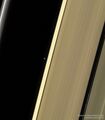File:Saturn-Earth-Moon-from Cassini.jpg: Difference between revisions
Siterunner (talk | contribs) No edit summary |
Siterunner (talk | contribs) No edit summary |
||
| Line 1: | Line 1: | ||
Remembering a Grand Finale of Cassini | |||
'''Remembering a Grand Finale of Cassini''' | |||
Hours before it takes its final plunge on September 15, 2017, Cassini will beam back its last batch of images — then prepare for the end. | Hours before it takes its final plunge on September 15, 2017, Cassini will beam back its last batch of images — then prepare for the end. | ||
| Line 8: | Line 10: | ||
Titan's gravity will slingshot Cassini over Saturn, above the planet's atmosphere, and — on April 26 — through a narrow void between the planet and the innermost edge of its rings. | Titan's gravity will slingshot Cassini over Saturn, above the planet's atmosphere, and — on April 26 — through a narrow void between the planet and the innermost edge of its rings. | ||
" | The Cassini mission command and control at NASA/JPL explains that a... "last 'kiss goodbye' will put Cassini into Saturn... This is a roller-coaster ride. We're going in, and we are not coming out — it's a one-way trip." | ||
| Line 21: | Line 23: | ||
''We all exist in a thin envelope of gas that surrounds the surface of Earth: a 7,917-mile-wide ball of rock that's flying through the void of space at a speed of about 450,000 mph, at least relative to the center of the Milky Way galaxy.'' | ''We all exist in a thin envelope of gas that surrounds the surface of Earth: a 7,917-mile-wide ball of rock that's flying through the void of space at a speed of about 450,000 mph, at least relative to the center of the Milky Way galaxy.'' | ||
🌎 | |||
[[Category:About Us]] | |||
[[Category:Anthropocene]] | |||
[[Category:Atmospheric Science]] | |||
[[Category:Biodiversity]] | |||
[[Category:Earth]] | |||
[[Category:Earth Science]] | |||
[[Category:Ecological Economics]] | |||
[[Category:Ecology Studies]] | |||
[[Category:Education]] | |||
[[Category:Environmental Protection]] | |||
[[Category:Nature]] | |||
[[Category:Planet Citizens]] | |||
[[Category:Water]] | |||
Latest revision as of 19:55, 9 July 2020
Remembering a Grand Finale of Cassini
Hours before it takes its final plunge on September 15, 2017, Cassini will beam back its last batch of images — then prepare for the end.
Cassini's death spiral will officially begin on April 22, 2017. That's when it will, for the last time, fly by Titan: an icy moon of Saturn that's bigger than our own, has a thick atmosphere, seas of liquid methane, and even rain.
Titan's gravity will slingshot Cassini over Saturn, above the planet's atmosphere, and — on April 26 — through a narrow void between the planet and the innermost edge of its rings.
The Cassini mission command and control at NASA/JPL explains that a... "last 'kiss goodbye' will put Cassini into Saturn... This is a roller-coaster ride. We're going in, and we are not coming out — it's a one-way trip."
Earth and Moon through Saturn's Rings
Image Credit: NASA, ESA, JPL-Caltech, SSI, Cassini Imaging Team; Processing & License: Kevin M. Gill
What are those dots between Saturn's rings? Our Earth and Moon. Just over three years ago, because the Sun was temporarily blocked by the body of Saturn, the robotic Cassini spacecraft was able to look toward the inner Solar System. There, it spotted our Earth and Moon -- just pin-pricks of light lying about 1.4 billion kilometers distant. Toward the right of the featured image is Saturn's A ring, with the broad Encke Gap on the far right and the narrower Keeler Gap toward the center. On the far left is Saturn's continually changing F Ring. From this perspective, the light seen from Saturn's rings was scattered mostly forward , and so appeared backlit. After more than a decade of exploration and discovery, the Cassini spacecraft ran low on fuel in 2017 and was directed to enter Saturn's atmosphere, where it surely melted.
Around 7.7 billion planet humans exist on that spec of light in the distance.
We all exist in a thin envelope of gas that surrounds the surface of Earth: a 7,917-mile-wide ball of rock that's flying through the void of space at a speed of about 450,000 mph, at least relative to the center of the Milky Way galaxy.
🌎
File history
Click on a date/time to view the file as it appeared at that time.
| Date/Time | Thumbnail | Dimensions | User | Comment | |
|---|---|---|---|---|---|
| current | 19:51, 9 July 2020 |  | 800 × 913 (77 KB) | Siterunner (talk | contribs) |
You cannot overwrite this file.
File usage
The following 3 pages use this file: